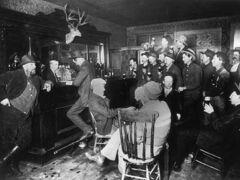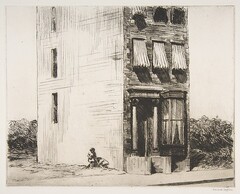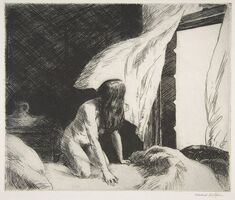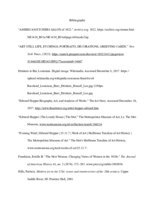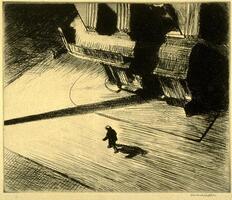Bibliography
(download pdf for a bibliography easier on the eyes and with indents)
“AMERICAN ETCHERS SALON of 1922.” Archive.org. 1922. https://archive.org/stream/bml-NE1410_B81a/NE1410_B81a#page/n0/mode/2up
“ART STILL LIFE, ETCHINGS, PORTRAITS, DECORATIONS, GREETING CARDS.” New York Times, (1923). https://search.proquest.com/docview/103211411/pageview/5C46628E10D3431EPQ/7?accountid=14667
Drinkers at Bar, Louisiana. Digital image. Wikimedia. Accessed December 8, 2017. https://upload.wikimedia.org/wikipedia/commons/thumb/e/e4Raceland_Louisiana_Beer_Drinkers_Russell_Lee.jpg/1280px-Raceland_Louisiana_Beer_Drinkers_Russell_Lee.jpg
"Edward Hopper Biography, Art, and Analysis of Works." The Art Story. Accessed December 10, 2017. http://www.theartstory.org/artist-hopper-edward.htm.
“Edward Hopper | The Lonely House | The Met.” The Metropolitan Museum of Art, I.e. The Met Museum, www.metmuseum.org/art/collection/search/366216.
“Evening Wind | Edward Hopper | 25.31.7 | Work of Art | Heilbrunn Timeline of Art History | The Metropolitan Museum of Art.” The Met's Heilbrunn Timeline of Art History, www.metmuseum.org/toah/works-of-art/25.31.7/.
Freedman, Estelle B. “The New Woman: Changing Views of Women in the 1920s.” The Journal of American History 61, no. 2 (1974): 372–393. www.jstor.org/stable/1903954.
Hills, Patricia. Modern art in the USA: issues and controversies of the 20th century. Upper Saddle River, NJ: Prentice Hall, 2001.
Hopper, Edward. "Boxing with Wallace Tremper ." Digital image. Google Books . Accessed December 6, 2017.
Hopper, Edward. "Camp Nyack, Greenwood Lake." Digital image. Chrisite's. September 28, 2010. Accessed December 8, 2017. http://www.christies.com/lotfinder/Lot/edwardhopper-1882-1976-camp-nyack-greenwood-5352776-details.aspx.
Hopper, Edward. "Dunes at Truro." Digital image. Sotheby's. Accessed December 5, 2017. http://www.sothebys.com/en/auctions/ecatalogue/2014/american-art-n09229/lot.9.html.
Hopper, Edward. “East Side Interior.” 1922. whitney.org. http://collection.whitney.org/object/6997
Hopper, Edward. “Evening Wind.” 1922. https://image.invaluable.com/housePhotos/Swann/98/603698/H0132-L116348699.jpg
Hopper, Edward, Interior (Model Reading), 1925. Oil on Canvas, 13.9 x 19.9 in. Chicago, The Art Institute of Chicago. Accessed December 3, 2017. https:// biblioklept.files.wordpress.com/2014/06/edward-hopper-interior-model1.jpg
Hopper, Edward. "Mansard Roof." Digital image. Edward Hopper. Accessed December 8, 2017. https://www.edwardhopper.net/mansard-roof.jsp.
Hopper, Edward. “Morning Sun.” ibiblio.org. 1952. http://www.ibiblio.org/wm/paint/auth/hopper/interior/hopper.morning-sun.jpg
Hopper, Edward. Nighthawks, 1942. Oil on Canvas, 33 1/8 x 60 in. Chicago, The Art Institute of Chicago. Accessed December 3, 2017. http://www.101bananas.com/art/hopper5.jpg
Hopper, Edward . "Night on the El Train ." Digital image. Metropolitan Museum of Art. Accessed December 5, 2017. https://www.metmuseum.org/art/collection/search/366215.
Hopper, Edward. “Office in a Small City.” totallyhistory.com. 1953. http://totallyhistory.com/wp-content/uploads/2012/12/Office-in-a-Small-City-by-Edward-Hopper.jpg
Hopper, Edward. "Sailing." Digital image. Carnegie Museum of Art. 2006. Accessed December 5, 2017. http://collection.cmoa.org/CollectionDetail.aspxitem=1016431&retUrl=default.aspx&retPrompt=Return.
Hopper, Edward. "Smash the Hun." Digital image. Norman Rockwell Museum . July 12, 2011. Accessed December 9, 2017. https://www.rockwell-center.org/essays-illustration/smashthe-hun/.
Hopper, Edward. Tables for Ladies, 1930. Oil on Canvas, 48 1/4 x 60 1/4 in. New York, The Metropolitan Museum of Art. Accessed December 3, 2017. https://thumbs-prod.si- cdn.com/SDNWO7VOe-N6N9hYk6xAd6TNstw=/800x600/filters:no_upscale()/https://public-media.smithsonianmag.com/filer/ee/1a/ee1a76e2-0531-46d4-bdac-3a4f915856d0/hb_3162.jpg
Jewell, Edward Alden. “AIMS AND ATTAINMENTS: This American Painter's Work Admirably Presented at Museum of Modern Art.” New York Times, (1923). https://search.proquest.com/artbibliographies/docview/100802175/pageview/5A0A7B2E3D194593PQ/1?accountid=14667
Jewell, Edward Alden. “ART GALLERIES OFFER A RICH DISPLAY.” New York Times, (1928). https://search.proquest.com/artbibliographies/docview/104433883/fulltextPDF/A29D5EC4969749D3PQ/1?accountid=14667
Jewell, Edward Alden. “ART: Academy of Design Exhibit. Rowlandson Drawings Shown. Jensen's Clipper Ships. Mrs. Harriman to Receive. Kit Kat Club Exhibition.” New York Times, (1923). https://search.proquest.com/pagemap/99229875/pageview/5C46628E10D3431EPQ/3?accountid=14667&t:lb=t
"John Sloan and the Philadelphians," by Edward Hopper, The Arts, April, 1927 — V. 11, pp. 168-178; illus.
Edward Hopper wrote an article for The Arts journal about John Sloan and the
wide reaching influence of American artists of the time. He aims to argue that Sloan and his
associates were the first important, completely American art movement, yet they were still
deeply influenced by European traditions. He looks at various Sloan pieces to identify how it
differs from European art and what ideas were brought to America from France and other
nations. Written for other artists and art historians, it gives a lot of insight into the works of the
Ashcans which Hopper learned from and into Hopper himself by revealing what he admired in
art. It is a good resource of Hopper’s thoughts on art and various American artists, but his
argument seems to be pretty obvious, especially considering that nearly all American artists at
the time were influenced by their European peers whom they learned from and shared galleries
with.
“John Sloan | Prone Nude | The Met.” The Metropolitan Museum of Art, I.e. The Met Museum, www.metmuseum.org/art/collection/search/367881.
Levin, Gail. Edward Hopper: an Intimate Biography. New York: Knopf, 1995.
The purpose of Levin’s book is to provide an in depth summary of Edward Hopper’s life and the art that he created during the different time periods in his life. Not only does this book provide an immense amount of information regarding his family, but it provides issues that Hopper faced throughout his life and gives specific details about his experience with different mediums of art and how he was influenced during these times. With over 35 sections in Levin’s book, the information one can find spans from his struggle to paint, his reactions to the war, and even his anxiety and illnesses. Since this book is factual, there are no biases and even provides a wide array of other helpful sources within the book as well. With such a wide variety of topics to explore, this book is no doubt a useful asset to anyone completing a project on Edward Hopper, or simply someone with an interest of Hopper and his art.
Levin, Gail. ”Hopper, Edward." Grove Art Online. Oxford Art Online. Oxford University Press. Web. 10 Oct. 2017. <http://www.oxfordartonline.com.proxy.lib.umich.edu/subscriber/article/grove/art/T038913>.
Lubbock, Tom. “Hopper, Edward: Early Sunday Morning (1930).” The Independent, Independent Digital News and Media, 7 Sept. 2006, www.independent.co.uk/arts-entertainment/art/great-works/hopper-edward-early-sunday-morning-1930-744415.html.
M’Bride, Henry. “Burchfield’s Admirable Drawings Are Shown.” The New York Herald, (1922). https://chroniclingamerica.loc.gov/lccn/sn83045774/1922-02-26/ed-1/seq-35/#date1=1922&index=0&rows=20&words=East+Interior+Side&searchType=basic&sequence=0&state=New+York&date2=1923&proxtext=East+Side+Interior&y=0&x=0&dateFilterType=yearRange&page=1
Ngai, Mae M. “Nationalism, Immigration Control, and the Ethnoracial Remapping of America in the 1920S.” OAH Magazine of History 21, no. 3 (2007): 11–15. www.jstor.org/stable/25162123.
“Night Shadows | Edward Hopper | 25.31.2 | Work of Art | Heilbrunn Timeline of Art History | The Metropolitan Museum of Art.” The Met's Heilbrunn Timeline of Art History, www.metmuseum.org/toah/works-of-art/25.31.2/.
“Pigeons.” Museum of Fine Arts, Boston, 26 July 2017, www.mfa.org/collections/object/pigeons-32498.
Rorabaugh, W. J. "Alcohol in America." OAH Magazine of History 6, no. 2 (1991): 17-19. http://www.jstor.org.proxy.lib.umich.edu/stable/25162814.
The purpose of “Alcohol in America” is to give a brief history of alcohol consumption in America, and to provide a clear link between alcohol and politics. Starting in the 18th century with the new settlers in America, and ending in the 90s, Rorabaugh explains the attitude shift over the course of a few hundred years. The attitude and acceptance of alcohol has changed several times and was more “respected” in the 1700s than it is now. Depending on the context surrounding the issue, alcohol was either something one could openly enjoy in a social environment, or it led to a prohibition. In regards to Hopper’s Eastside Interior and the context around the era, alcohol served a pivotal role in the 1920s due to the prohibition and its importance to the sociopolitical scene. This piece provides a very clear and detailed history of alcohol consumption and how various groups, like the Quakers or the Women’s Crusade felt about the subject. Rather than choosing to be against or support alcohol, the author gives a timeline of events without showing much bias. The author concludes by saying that opinions toward the subject are constantly changing and will continue to do so.
Saloon in the Old West. Digital image. Pinterest. Accessed December 8, 2017. https://i.pinimg.com/736x/28/ba/73/28ba73edea48042bce7393defaf572b9--old-west-western-art.jpg
Souter, Gerry. Edward Hopper Light and Dark. (Parkstone International, 2012). https://ebookcentral.proquest.com/lib/umichigan/reader.action?docID=915182.
This is a great book for anyone wanting to learn about Edward Hopper’s life and works. This
book is a biography chronicling Hopper’s life and career from birth until death, working through
the different phases of his life and career. The book is actually fairly short, and the prose is not
difficult, so most interested people should have no problem reading it. I was able to find just
about all of the information about the stages of Hopper’s career and his thematic development I
needed in this book, so it was a great base for my research and would probably serve anyone
with similar goals very well.
“THE WORLD OF ART:: Brooklyn Society of Etchers:.” New York Times, (1922). https://search.proquest.com/artbibliographies/docview/100094532/pageview/5A0A7B2E3D194593PQ/4?accountid=14667
Women’s Fashion, 1920s. Digital image. Pinterest. Accessed December 8, 2017. https://i.pinimg.com/736x/6e/de/6c/6ede6c5ce578d217ddd34d9b315606fe--vintage-fashion-style fashion-women.jpg
Created For
K-12 EducatorK-12 Student
Museum Visitor
UMMA Docent
UMMA Staff
University Faculty
University Student
Rate this Resource
AVG: 0 | Ratings: 0
& Author Notes
All Rights ReservedLast Updated
December 11, 2017 1:30 p.m.Report
Reporting Policy

